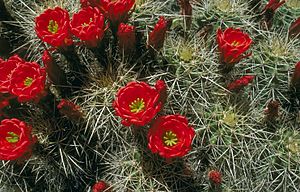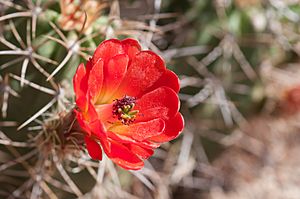Echinocereus triglochidiatus facts for kids
Quick facts for kids Echinocereus triglochidiatus |
|
|---|---|
 |
|
| Conservation status | |
| Scientific classification | |
| Synonyms | |
|
Echinocereus mojavensis |
The Kingcup Cactus (scientific name: Echinocereus triglochidiatus) is a type of hedgehog cactus. It's also known as the claretcup or Mojave mound cactus. This cool plant grows naturally in the southwestern United States and northern Mexico. You can find it in many different places, from hot deserts to rocky hillsides and mountain forests. It often grows best in shady spots.
Contents
What Does It Look Like?
This cactus usually grows in large clumps, forming round piles of stems. These stems can be shaped like balls or cylinders. The cactus is covered in many spines and has a somewhat woolly feel.
Its flowers are very eye-catching! They are shaped like funnels and can be about 8 to 9 centimeters (about 3.5 inches) wide. Their color ranges from bright scarlet red to orange-red. Inside the flower, there's a thick area that holds nectar and many thin, pink stamens (the parts that produce pollen). Hummingbirds love these flowers and help pollinate them.
Different Types and Protection
There are several different types, or "varieties," of the Kingcup Cactus. However, not all scientists agree on how to classify every single one.
One special variety, called Echinocereus triglochidiatus var. arizonicus, is considered an endangered species in the United States. This means it's very rare and needs protection. It only grows where Arizona and New Mexico meet the border with Mexico. Sometimes, this variety is grouped with another cactus called Echinocereus coccineus.
Here are some examples of different varieties and their protection status:
- E. t. var. arizonicus (Arizona hedgehog cactus) is endangered.
- E. t. var. melanacanthus (black-spine claret-cup hedgehog) has rules about how it can be collected.
- E. t. var. neomexicanus (Mexican claret-cup hedgehog) also has rules about collecting it.
The Kingcup Cactus is also special because it's the official state cactus of Colorado!
Where Does the Name Come From?
The scientific name triglochidiatus might sound complicated, but it has a cool meaning! It probably comes from two old words: "tri-", which means "three", and "glochidium", which refers to a barbed hair or arrow point. So, the name likely means "having three arrow points," possibly describing its spines.
See also
 In Spanish: Echinocereus triglochidiatus para niños
In Spanish: Echinocereus triglochidiatus para niños



